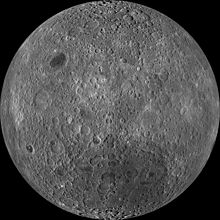 |
| The far side of the Moon as photographed by the Lunar Reconnaissance Orbiter (LRO) |
The far side of the moon is only covered by 1% of maria (darker surfaces on the moon) compared to 31.2% on the near side of the moon. Until the late 1950's very little was known about the far side of the Moon, because of Libration. Our lack of knowledge about the far side of Moon caused so much speculation, one example of a feature that can be seen through libration is the Mare Orientale. This is a prominent impact basin which spans almost 1,000km. Until 1906 this wasn't even named as a feature on the Moon. In 1906 Julius Franz in Der Mond named this as a feature. In the 1960's the true nature of the basin was first discovered and photographed in detail by the Lunar Orbiter 4 in 1967.
As these landscapes were mostly discovered by Soviet space probes and Soviet scientists selected names for them, although this caused some controversy so the International Astronomical Union (IAU) now name lunar features.
.

No comments:
Post a Comment